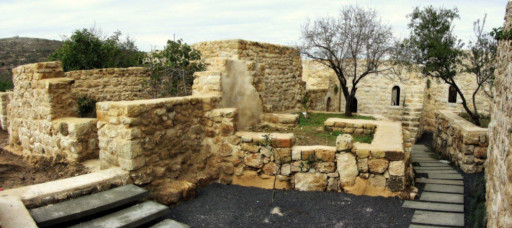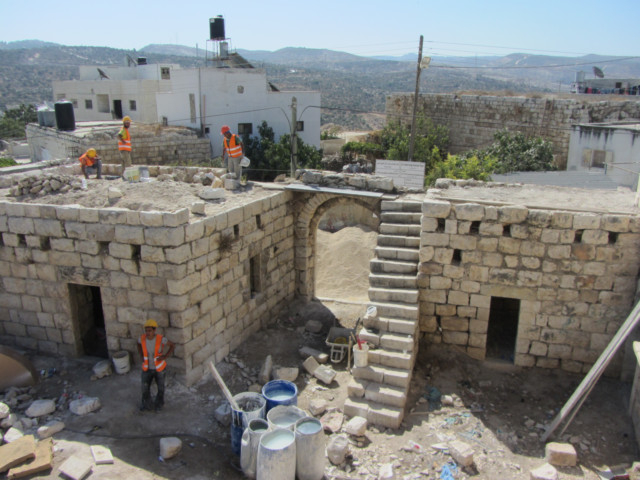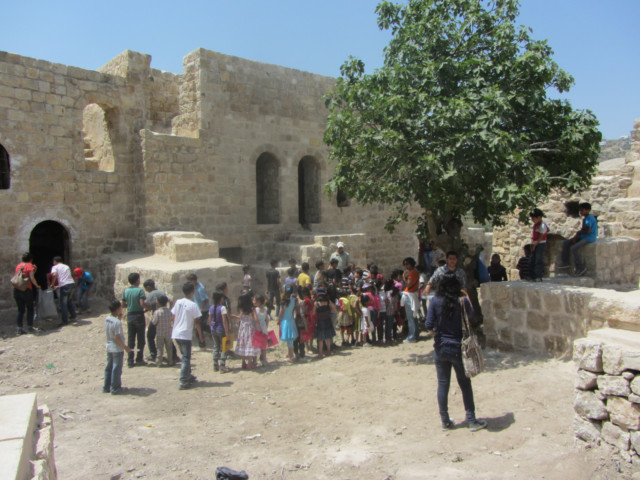
Generally, young architects take to modernisation of building designs like fish to water. However, in the West Bank of Palestine, a group of architects — most of whom have international postgraduate degrees and could easily have found lucrative careers abroad — has returned home to preserve architectural heritage of the holy land, a heritage that is either being deliberately destroyed by the Israelis or being neglected by Palestinians. For the former, cultural heritage has become a battleground to stake a claim to the land — a war in which they have the ascendency — and for the latter, the upkeep of historically important sites and buildings is a luxury they cannot afford.
Riwaq, a Palestinian non-profit organisation established in 1991 in Ramallah, provides these passionate young architects with a platform to use their talents to preserve the heritage.
It took Riwaq 13 years to prepare a record of historical buildings in Palestine, before moving on to rehabilitation and development of the architectural heritage. This involved restoring the remains of the many civilisations that existed here. The various strata, with their different styles, make up the complex identity of Palestine, and Riwaq is committed to not only protecting structures built by the nobility and religious sites but also the valuable and varied urban, peasant and nomad architecture. To do this successfully it faces the challenge of convincing the public and the decision makers that historical buildings and centres are important tools for development, not liabilities.
Riwaq has been the recipient of many notable awards — the Dubai International Award for Best Practices, in 2007, and the Curry Stone Design Prize, in November 2012. Their offices are fittingly housed in an old building in Ramallah, where I meet a youthful, fun-loving and energetic team to learn more about their motivation for being there and the amazing work they do, which may even be viewed as a non-violent form of resistance against Israeli occupation.
Lana Judeh, whose youthful looks belie her talents, is presently heading a project that is rehabilitating a historical site in the north of Ramallah. She obtained her masters degree in London, in architecture and cultural identity, and when asked why she chose Riwaq instead of the private sector, she replies, “This place provides an opportunity for me to work and develop in a way I can’t elsewhere. I have learnt the geography of Palestine, which is very unique, but most of all, that to design new things you need to understand the old so you can build on it. Also this is a highly qualified team, and the intellectual discourse here is hard for me to find elsewhere.”
Judeh’s project is the “Abwein Historic Centre” from the Ottoman period, famous for its “Throne Village Palace” where rulers collected taxes from peasants. To begin with, Riwaq implemented preventive conservation of the palace a few years ago, restoring it from the outside to protect it from any further deterioration.
“We are trying to bring life back to abandoned areas that are either run-down or in ruins,” Judeh says. “Our restoration work has many aspects to it, beginning with a core building and then extending it to the whole neighbourhood. The involvement of locals in cleaning and beautifying their public space brings back their focus on the centre of the old town from which they have moved away and where they only visit the mosque or attend funerals.”
This particular site lay abandoned for 30 years. “It is frustrating at the beginning, especially as an outsider, because heritage is not a priority for the local communities,” Judeh says. “Two years later, we see how it pays off, as the quality of life has changed, with children playing in clean courtyards, free of the garbage that used to be dumped there, and a local women’s organisation will use the restored building.”
Judeh says Riwaq has two options: “Either we renovate for public use, where a local organisation rents the building from the original owner for 15 years. In that case, the owner pays nothing and gets his building back, restored, after 15 years. Or in the case of Abwein, if the owner wants to restore his building for private use, we ask for a contribution — for example, providing the owner with building materials — and he completes the restoration under Riwaq’s supervision.”
In other instances, Riwaq provides owners with material and they complete the restoration themselves. In essence, Riwaq works in partnership with the owners and does not impose its will on them.
Michel Salameh is another young architect with Riwaq. “I work here because it is a place where I feel I am doing something special for my community by protecting the heritage of Palestine,” he says.
Salameh is heading the “Adh Dhariyeh” project, in the south of Hebron, where he began with single-building restoration and has progressed to a community centre and two schools. He explains, “This used to be a Roman fort and people in the village lived in a network of caves under the buildings, and each country that invaded the holy land used Dhariyeh as a protective fort against enemies approaching from the south.
“Dhariyeh is one of 50 historical sites whose renovation Riwaq has undertaken and which constitute 50 per cent of the architectural heritage of Palestine.” Salameh says. “There are almost 900 old buildings and the project is funded by the Arab Fund in Kuwait.
“The 50 historical centres mark a shift as Riwaq moves away from a single-building approach towards a community approach, emphasising entire historical fabrics.”
Riwaq’s goal is to breathe life back into 50 per cent of Palestine’s heritage buildings and the communities in and around them, and to secure and reinforce the Palestinian identity that their architecture embodies.
Salameh explains the issue of ownership regarding his project: “The municipality enters into a contract to use the buildings we renovate, and they revert to the owner after 12 to 15 years. Today the municipality is using them for a Sharia court, lawyers’ offices and for various organisations that work in the area.”
Almost all the inhabitants had abandoned the place, with less than 20 per cent living there. While an old commercial street was empty, so was the home of a Shaikh which Riwaq has renovated to serve as a hostel.
It is the renovated hostel which Salameh believes will bring back life to the old centre in south Hebron. “From a dump, we renovated and landscaped it to how it used to be,” Salameh says. “The history of the building makes you imagine what it was like before.” And these projects have already created employment for the locals.
In most countries historical buildings are often protected for aesthetic reasons. However in Palestine, the conservation of historical buildings and sites is viewed as a tool of economic and social development as well as a form of non-violent resistance against the occupation.
Renad Shqeirat, who studied for her bachelor’s degree in Chicago and worked there for two years, returned to Palestine in 2007 to work on the rehabilitation of a building in the old city of occupied Jerusalem. She joined Riwaq in 2008 and later, in 2011, obtained her masters in Madrid. Today, her focus, she says is, “integrating environmental strategies in the restoration process”, such as “integrating green areas with a water management plant on site, which has just begun in the ‘Beit Ur’ project that I head”.
Riwaq has kept pace with the modern world and has “gone green”. Shqeirat’s eyes light up and she becomes animated as she says, “Riwaq shaped my thinking about cultural heritage and I am appreciative of the building that takes note of the environment and the people, so that its impact on the social fabric is more sustainable, starting with what there is to reintroduce in terms of modern values and uses”.
I also meet Sahar Qawasmi, who completed her masters in Ohio, the United States, and worked awhile in the country before returning home. “I work with all the projects, developing a cultural programme at Riwaq, bringing different components of rehabilitation into a multidisciplinary approach that takes cognisance of the economy, jobs, culture, art, traditions, rituals and people-to-people exchanges,” Qawasmi says.
In short, her holistic approach puts all of Riwaq’s work under one umbrella: “I am working with villages, digging for stories about local initiatives and public spaces to work with communities in introducing cultural events for promoting tourism — with music, dance, arts and craft markets.” She adds, “We just completed a project, Qalandiya International, with six other institutions, over 15 days, with activities in the West Bank, Gaza, occupied Jerusalem and Nazareth. It was unique in that we stitched together fragmented villages and cities, bringing Palestinians as well as foreigners together.”
Qawasmi reflects on her experience in Cincinnati, where she worked with the homeless and on renovation of historical sites, and then in California, where she was involved in building low-income housing for children in foster homes. “All along, I was interested in architecture that responds to the needs of communities, bettering urban life, finding solutions through architecture,” she says. “Here in Palestine I am socially inspired by my experiences of visiting abandoned buildings and eventually bringing them back to life, all the while having this dialogue in my head.”
Prior to her stint in the US she had worked for Riwaq as part of the team that set about registering every historical building in Palestine, and it was this experience that brought her back. “I admit there are many difficulties with the work as we navigate through layers of complexities, and it is much harder than building a new structure, but this brings back history and traditions,” she says. “Seeing homes come alive and people going back to the residences of their forefathers — I would never exchange it for anything else.”
On that positive note, I leave Riwaq knowing that the future of Palestinian cultural heritage is in the hands of these extremely capable and passionate young architects committed to make a difference.
Rafique Gangat, author of Ye Shall Bowl on Grass, is based in Occupied Jerusalem.






